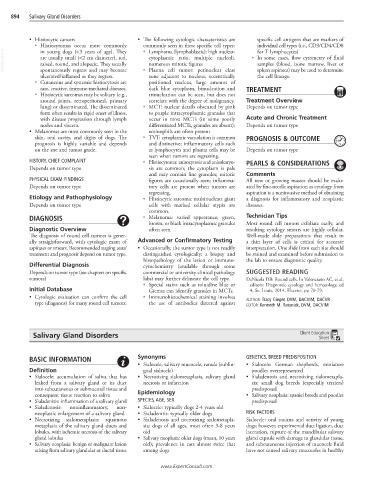Page 1783 - Cote clinical veterinary advisor dogs and cats 4th
P. 1783
894 Salivary Gland Disorders
• Histiocytic cancers • The following cytologic characteristics are specific cell antigens that are markers of
○ Histiocytomas occur more commonly commonly seen in these specific cell types: individual cell types (i.e., CD3/CD4/CD8
VetBooks.ir are usually small (<2 cm diameter), red, cytoplasmic ratio, multiple nucleoli, ○ In some cases, flow cytometry of fluid
○ Lymphoma (lymphoblastic): high nuclear-
in young dogs (<3 years of age). They
for T lymphocytes)
samples (blood, bone marrow, liver or
numerous mitotic figures
raised, round, and alopecic. They usually
spontaneously regress and may become
ulcerated/inflamed as they regress. ○ Plasma cell tumor: perinuclear clear spleen aspirates) may be used to determine
zone adjacent to nucleus, eccentrically
the cell lineage.
○ Cutaneous and systemic histiocytosis are positioned nucleus, large amount of
rare, reactive, immune-mediated diseases. dark blue cytoplasm, binucleation and TREATMENT
○ Histiocytic sarcomas may be solitary (e.g., trinucleation can be seen, but does not
around joints, retroperitoneal, primary correlate with the degree of malignancy. Treatment Overview
lung) or disseminated. The disseminated ○ MCT: nuclear details obscured by pink Depends on tumor type
form often results in rapid onset of illness, to purple intracytoplasmic granules that
with disease progression through lymph occur in most MCTs (in some poorly Acute and Chronic Treatment
nodes and viscera. differentiated MCTs, granules are absent); Depends on tumor type
• Melanomas are most commonly seen in the eosinophils are often present
skin, oral cavity, and digits of dogs. The ○ TVT: cytoplasmic vacuolation is common PROGNOSIS & OUTCOME
prognosis is highly variable and depends and distinctive; inflammatory cells such
on the site and tumor grade. as lymphocytes and plasma cells may be Depends on tumor type
seen when tumors are regressing.
HISTORY, CHIEF COMPLAINT ○ Histiocytoma: anisocytosis and anisokaryo- PEARLS & CONSIDERATIONS
Depends on tumor type sis are common; the cytoplasm is pale
and may contain fine granules; mitotic Comments
PHYSICAL EXAM FINDINGS figures are occasionally seen; inflamma- All new or growing masses should be evalu-
Depends on tumor type tory cells are present when tumors are ated by fine-needle aspiration as cytology from
regressing. aspiration is a noninvasive method of obtaining
Etiology and Pathophysiology ○ Histiocytic sarcoma: multinucleate giant a diagnosis for inflammatory and neoplastic
Depends on tumor type cells with marked cellular atypia are diseases.
common.
DIAGNOSIS ○ Melanoma: varied appearance; green, Technician Tips
brown, or black intracytoplasmic granules Most round cell tumors exfoliate easily, and
Diagnostic Overview often seen resulting cytology smears are highly cellular.
The diagnosis of round cell tumors is gener- Well-made slide preparations that result in
ally straightforward, with cytologic exam of Advanced or Confirmatory Testing a thin layer of cells is critical for accurate
aspirates or smears. Recommended staging tests/ • Occasionally, the tumor type is not readily interpretation. One slide from each site should
treatment and prognosis depend on tumor type. distinguished cytologically; a biopsy and be stained and examined before submission to
histopathology of the lesion or immuno- the lab to ensure diagnostic quality.
Differential Diagnosis cytochemistry (available through some
Depends on tumor type (see chapters on specific commercial or university clinical pathology SUGGESTED READING
tumors) labs) may further delineate the cell type. DeNicola DB: Round cells. In Valenciano AC, et al,
○ Special stains such as toluidine blue or editors: Diagnostic cytology and hematology, ed
Initial Database Giemsa can identify granules in MCTs. 4, St. Louis, 2014, Elsevier, pp 70-79.
• Cytologic evaluation can confirm the cell ○ Immunohistochemical staining involves AUTHOR: Tracy Gieger, DVM, DACVIM, DACVR
type (diagnosis) for many round cell tumors. the use of antibodies directed against EDITOR: Kenneth M. Rassnick, DVM, DACVIM
Salivary Gland Disorders Client Education
Sheet
BASIC INFORMATION Synonyms GENETICS, BREED PREDISPOSITION
• Sialocele, salivary mucocele, ranula (sublin- • Sialocele: German shepherds, miniature
Definition gual sialocele) poodles overrepresented
• Sialocele: accumulation of saliva that has • Necrotizing sialometaplasia, salivary gland • Sialadenosis and necrotizing sialometapla-
leaked from a salivary gland or its duct necrosis or infarction sia: small dog breeds (especially terriers)
into subcutaneous or submucosal tissue and Epidemiology predisposed
consequent tissue reaction to saliva • Salivary neoplasia: spaniel breeds and poodles
• Sialadenitis: inflammation of a salivary gland SPECIES, AGE, SEX predisposed
• Sialadenosis: noninflammatory, non- • Sialocele: typically dogs 2-4 years old
neoplastic enlargement of a salivary gland • Sialadenitis: typically older dogs RISK FACTORS
• Necrotizing sialometaplasia: squamous • Sialadenosis and necrotizing sialometapla- Sialocele: oral trauma and activity of young
metaplasia of the salivary gland ducts and sia: dogs of all ages, most often 3-8 years dogs; however, experimental duct ligation, duct
lobules, with ischemic necrosis of the salivary old laceration, rupture of the mandibular salivary
gland lobules • Salivary neoplasia: older dogs (mean, 10 years gland capsule with damage to glandular tissue,
• Salivary neoplasia: benign or malignant lesion old); prevalence in cats almost twice that and subcutaneous injection of mucocele fluid
arising from salivary glandular or ductal tissue among dogs have not caused salivary mucoceles in healthy
www.ExpertConsult.com
.ExpertConsult.com
www

